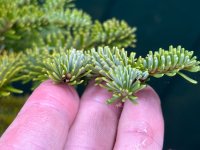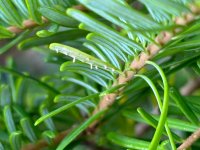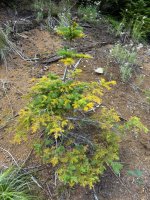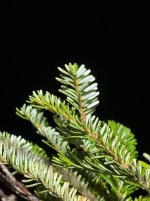@River's Edge
Good questions.
The tree is healthy. Perhaps a 7/10.
Lighter color in the needles is mostly from excessive sun exposure combined with a poor growing site. Less-exposed foliage is darker. Other stunted trees in the area had a similar hue. Some yellowing is also just end-of-season needle drop.
Trunk discolorations are from the aging bark, popped resin blisters, dirt, and epiphytes. The rusty orange spots and green blotches are lichens.
Current seasons growth is healthy. Buds for next year look promising.

My experience is that most stunted trees in the wild contain minor pathogens of some kind. I still collect those that aren’t perfectly healthy. It comes down to how bad the ailment is and is it curable?
The main pathogen to look for and avoid when collecting firs is Balsam Woolly Adelgid. I haven’t found an effective treatment so it’s a dealbreaker. The insect is especially damaging to silver and subalpine firs and will kill them. Nobles seem more resistant.
Other diseases like needle casts and rusts seem less of a problem.
As you know, our Abies are strong trees! I still quarantine new collections but have found that proper aftercare and husbandry seem to alleviate most issues.
Earlier this year I knowingly collected and barerooted a silver fir infected with fir-blueberry rust and amarillia growing at its base. The rust will clear itself up if deprived of alternate hosts. Amarillia causes root rot.
3 months in and the tree is recovering nicely… I’m confident it will make a full recovery.



This other tree nearby had a sever outbreak..

Gouting caused by balsam woolly adelgid. Even if the insect could be eradicated on a tree the structural deformity it causes remains. You can see how the swelling prevents healthy buds from forming and elongating next season.




















